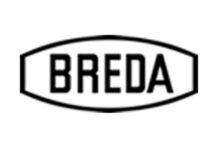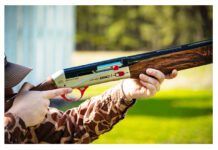For many years, the Benelli line of Italian-made shotguns were imported into this country exclusively by Heckler & Koch Inc. in Sterling, Virginia. However, this distribution arrangement was not renewed when it expired at the end of 1997.
In January 1998, Benelli started handling its own importing, marketing and distribution through a newly-formed company called Benelli USA Corp. The new company is headquartered in a facility near Beretta’s Accokeek, Maryland location.
During the first part of this year, Heckler & Koch began importing the Fabarm line of shotguns. Established in 1900, Fabarm (Fabbrica Bresciana Armi S.p.A.) is the direct descendant of one of the great gunsmithing dynasties in Brescia, Italy—the Galesi family.
Barrels on all Fabarm shotguns are made using the manufacturer’s innovative process of deep drilling and honing of steel barrel stock. CNC lathes are then used to create the external profile and choke case of the barrels, to ensure the barrel and choke case are properly aligned. Every barrel is manually tested with a “black line” optical system to guarantee straightness.
We thought it might be interesting to test a shotgun that Heckler & Koch used to import, a Benelli, against a scattergun the company is currently importing, a Fabarm. The two shotguns in this head-to-head comparison are the Benelli Montefeltro Super 90 and the Fabarm Gold Lion.
The Test Guns
Both of the guns in this test were 12 gauge semiautomatic shotguns intended for hunting. They had operating systems that could fire both 2-3/4- and 3-inch shotshells without adjustments. Each had a 26-inch barrel, interchangeable choke tubes and a tubular magazine that held three 2-3/4-inch shells.
The $925 Benelli Montefeltro was a recoil-operated shotgun. Its steel barrel had a low-glare blue finish, while the aluminum alloy receiver had a shiny black finish. The alloy trigger guard was matte black. This model’s stock was made of good-looking walnut with a smooth, satin finish. A set of black plastic shims provided with the gun allowed the stock’s drop to be adjusted to suit the individual shooter.
[PDFCAP(1)].Priced at $914, the Fabarm Gold Lion was a gas-operated shotgun. In our opinion, the walnut used to construct its stock wasn’t as good looking as that of the Benelli. However, the stock did have a well-applied oil finish and an olive wood pistol grip that contrasted nicely. The aluminum alloy receiver was matte black, while the steel barrel had a glare-resistant blue finish. The trigger guard was made of black plastic.
[PDFCAP(2)].Observations
We considered the Benelli’s workmanship to be very good. The stock had neatly cut checkering and no blemishes, but the black rubber recoil pad with spacer was slightly undersized. Wood-to-metal mating was faultless. Although the trigger had moderate side-to-side play, there was only a minor amount of play in other moving parts. A few insignificant tool marks were noted on the barrel extension and on the bottom of the bolt.
Our testers felt the Fabarm’s metal and wood work was almost as good as that of the Benelli. The stock’s checkering was neatly done, but some of the cuts were a little ragged. The back of the forend was painted black. Installation of the black rubber recoil pad with spacer was precise. In wood-to-metal mating, no gaps or other shortcomings were found. There was a small amount of play in most moving parts. Several minor tool marks were noted on the bottom rear of the bolt.
Handling
The Benelli Montefeltro’s slightly lighter weight and more even balance allowed it to swing the fastest, yet it had enough muzzle heft to follow through on flying targets fairly well. Shouldering was quick and natural. The rubber recoil pad was non-slip, and its beveled heel and non-protruding toe made it quite comfortable. Establishing a proper cheek-to-stock fit with a good view of the sighting plane was easy. Although the pistol grip and forend were relatively slim, they afforded a comfortable and secure grasp.
We thought the Fabarm Gold Lion’s greater weight and more muzzle-heavy balance slowed swinging a bit, but provided better follow through. Shouldering was smooth. The recoil pad’s leather-covered face was fairly nonslip, but the pad’s protruding toe was a source of discomfort. The wide comb afforded a comfortable cheek-to-stock fit. The pistol grip had a palm swell on the right side, so right-handed shooter found it and the forend hand filling.
Controls
Operation of the Benelli was unusual, but it could be mastered after about an hour of familiarization. When this shotgun was cocked, a round was not released from the magazine when the bolt was retracted. So, a magazine cutoff switch wasn’t needed. Feeding a round from the magazine and into chamber without pulling the trigger was accomplished by pushing the cartridge drop lever upward and then retracting the bolt. The bolt automatically locked back after the last round was fired, and releasing it was a simple matter of depressing the blued button at the right front of the receiver. When pushed from left to right, the crossbolt safety at the rear of the trigger guard prevented firing by blocking the trigger. Right-handed shooters could readily manipulate all of the controls, and the safety was reversible for left-handed shooters.
The Fabarm operated in the traditional manner. When the bolt was retracted, a round was released from the magazine. Switching the shotshell in the chamber without disturbing the rounds in the magazine was accomplished by sliding the magazine cutoff forward, holding it there and then retracting the bolt. Releasing the bolt, which automatically locked back after the last round, was a simple matter of depressing the gold-plated button at the left front of the receiver. This shotgun’s safety was located in the same place and worked in the same manner as that of the Benelli. It also was reversible. Most of our shooters felt the Gold Lion’s bolt release was more conveniently placed than the Benelli’s release, which was placed on the other side of the receiver. All of the controls worked smoothly.
Sights
For sighting, the Benelli Montefeltro had a ventilated 5/16-inch-wide barrel rib with a cylinder-shaped orange plastic bead on the front. To be more precise, the bead was positioned 1-1/8 inches behind the muzzle. The top of the rib and the receiver were serrated to reduce glare. We felt this arrangement provided a satisfactory sighting reference.
The Fabarm Gold Lion’s sighting system, which was similar to that of the Benelli, consisted of a ventilated 1/4-inch-wide barrel rib with a cylinder-shaped orange plastic bead on the front. It was positioned just behind the muzzle. This bead was larger in diameter than the Benelli’s, so it was easier to find in a hurry. Serrations on the top of the rib and the receiver did a good job of preventing glare.
At The Range
The Benelli’s functioning was admirable. It flawlessly digested all of the 2-3/4- and 3-inch shotshells we used. The bolt’s movement was very smooth. Furthermore, it seemed to be under less spring tension than the Fabarm’s bolt, making it significantly easier to retract. The trigger pull had a lot of takeup, but released cleanly at 4-3/4 pounds with little overtravel.
A wrench and five screw-in choke tubes were supplied with the Montefeltro. The chokes were rated as Skeet, Improved Cylinder, Modified, Improved Modified and Full. All of the chokes produced well-distributed shot patterns with the Winchester Super-X No. 8 Small Game Hunter and Federal Classic No. 6 Magnum loads we tried.
No functioning problems were encountered while firing the Fabarm. The movement of the bolt was smooth, but it wasn’t as slick as the Benelli’s bolt. It was also harder to retract, but only an average amount of muscle was needed to pull the bolt all the way to the rear. The trigger’s 4-1/4-pound pull had moderate takeup and minor overtravel.
Like the Montefeltro, the Gold Lion came with five screw-in choke tubes and a wrench. The chokes were rated as Cylinder, Improved Cylinder, Modified, Improved Modified and Full. These chokes yielded satisfactory shot patterns with uniform pellet spread.
































WHO MADE THE CHOKE TUBES FOR THE HK GOLD LION ,. THANKS